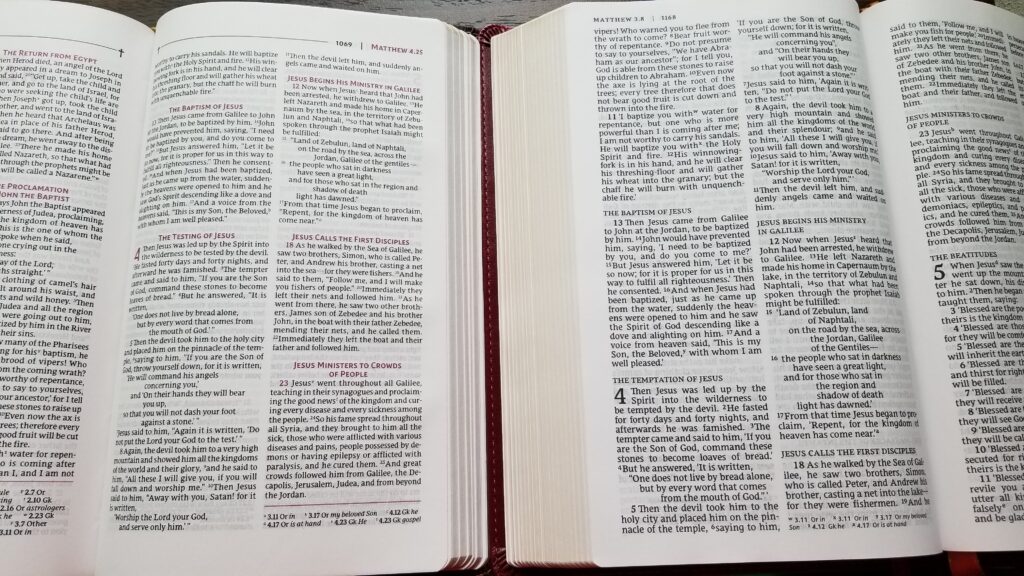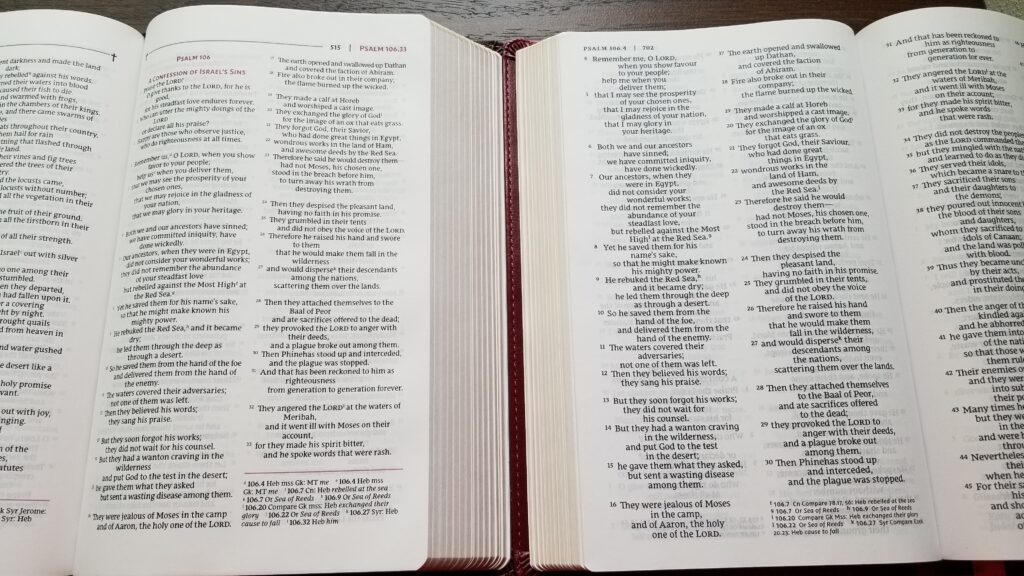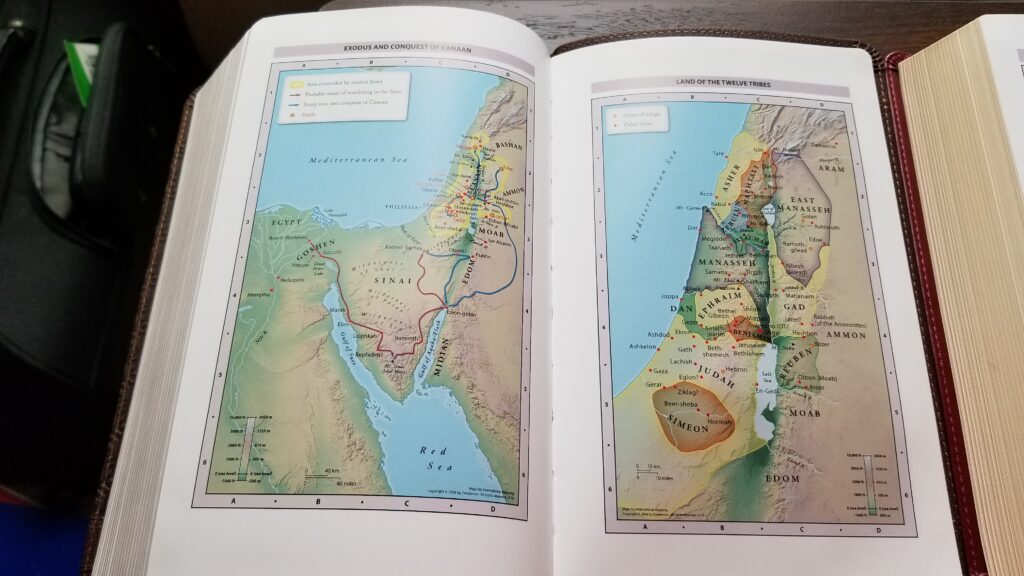The first printed editions of the New Revised Standard Version Updated Edition (NRSVue) have begun to appear over the past month or two. Zondervan, an imprint of Harper Collins Christian Publishing, has recently released several editions. I pre-ordered the personal size edition with Apocrypha in brown imitation leather from ChristianBook, and I’ve been using it for prayer and bible reading over the past month and a half.
I can happily recommend this edition. It is compares favorably to the NRSV Personal Size edition from Catholic Bible Press (also a subsidiary of Harper Collins Christian Publishing) which has been one of my favorites over the past few years.
Both editions are nearly identical in size, measuring about 8.9 inches long and 5.75 inches wide. The new Zondervan NRSVue has an imitation leather cover with a relatively coarse texture, along with style accents along the border on the front and back. Overall, the cover feels rougher and more “rubber-like” than the smooth, supple imitation leather on the Catholic Bible Press NRSV-CE. I’d say the texture feels similar to the genuine leather cover on the most recent two editions of the New Oxford Annotated Bible.

Both editions have gold-gilded page edges. The gilding looks slightly smoother and higher quality on the Zondervan edition, but the downside is that many pages were stuck together when I first received it. As with many premium bibles, I spent some time carefully separating the pages when I first received the Zondervan edition. By contrast, the pages were already separated when I received the NRSV-CE from Catholic Bible Press.

The new Zondervan edition also features a sewn binding, two ribbon markers, and a double-column page layout. The ribbons are 3/8-inch wide compared to the 1/2-inch ribbons on the Catholic Bible Press NRSV-CE.
The biggest difference between the two bibles is the paper and typesetting. This is where the Catholic Bible press edition falls a little below the ideal. It has relatively thin paper with a bold 9.5-point font. The line-matched printing keeps ghosting manageable, but even after using this bible for two years, I find myself wishing that there was less ghosting. The page layout also feels cramped, with very little whitespace and relatively few words per line of text.
By comparison, the new Zondervan NRSVue is a marked improvement in my view. The paper is more opaque and a brighter white color. Ghosting is almost non-existent. Chapter numbers and section headings are printed in burgundy-colored text, which adds a pop of color to the page compared to the black and white printing in the Catholic Bible Press NRSV-CE. Zondervan used 8.5-point font in the NRSVue, which creates room for more words in each line of text. The text is a touch small for my liking, but I think I prefer the better page layout enough to justify the smaller text. The text size is also comparable to other bibles in the same size segment, like the Cambridge REB with Apocrypha — one of my favorite bibles.
I’ll include photos from prose and poetry sections below to illustrate the page layouts in both editions:


Both editions feature the same set of color maps at the back of the Bible. Otherwise, these are reader’s bibles with very few explanatory helps. The Catholic Bible Press edition features extremely brief book introductions but no explanatory notes. The Zondervan edition does not include any book introductions.
As a final note, I’ve found reading and praying with the NRSVue to be a very similar experience to the NRSV-CE. The updates to the translation have not changed the tone or character of the text. The NRSVue has attracted some debate because of the translators’ choice to rephrase words like “paralytic” and “demoniac” to “afflicted with paralysis” and “possessed by demons.” So far, I have not noticed any of these changes during my reading, which has covered some of Paul’s letters and parts of the Old Testament and 1 Maccabees.
My sense is that the translators were careful to stay close to the NRSV’s language and not indulge in highly speculative translations. Even in cases where the NRSV was updated to reflect a new scholarly consensus, their updates seem careful and restrained. A case in point is Galatians 2:16. Traditional translations have rendered Paul’s language as a contrast between works of the law and faith in Christ. The modern scholarly debate, reflected in multiple recent translations and study bibles, has shifted toward a translation that contrasts works of the law with Christ’s own faithfulness. As an example, here is how the New English Translation (NET) renders this verse:
yet we know that no one is justified by the works of the law but by the faithfulness of Jesus Christ. And we have come to believe in Christ Jesus, so that we may be justified by the faithfulness of Christ and not by the works of the law, because by the works of the law no one will be justified.
Galatians 2:16 NET
The NRSVue chose a simple substitution of the alternate rendering in the textual notes of the original NRSV: “faith of Christ.” As I understand it, this is an easily defensible translation of the Greek grammar without taking the additional interpretive step of rendering “faith” as “faithfulness”:
yet we know that a person is justified not by the works of the law but through the faith of Jesus Christ. And we have come to believe in Christ Jesus, so that we might be justified by the faith of Christ and not by doing the works of the law, because no one will be justified by the works of the law.
Galatians 2:16 NRSVue
Overall, if you like the original NRSV I can easily recommend the NRSVue. The translators were respectful of the original edition and retained much of its language and style. There are few jarring departures.
The Personal Size edition from Zondervan is currently available for $36.99 from ChristianBook and $39.81 from Amazon. This is an excellent price range for the quality of this edition. I can easily recommend it.

https://www.catholic.com/magazine/online-edition/new-frontiers-in-politically-correct-bible-translation
I would not trust the NRSVue. Better stick with RSVCE, RSV2CE, ESVCE, DRB, NABRE, JB, RNJB and New Catholic Bible.
Interesting. The thing about ‘arsenokoitai’ makes me wonder whether this translation can receive an imprimatur/ecclesiastical approval, since one could argue the translation choice is positively misleading. This is a more serious matter than the original NRSV’s use of gender-inclusive language, which does not seem to me grounds for denying an imprimatur (even if I don’t personally agree with the choice).
That said, I wouldn’t be surprised if, even so, it will be possible for the NRSVue to get the approval of some episcopal conference or other. I also wonder if just calling this an ‘Updated Edition’ rather than a completely new translation was a shrewd choice that will let them grandfather in the earlier imprimatur in some way, or otherwise streamline that process.
I don’t know biblical Greek, so I can’t offer any substantive opinion on the translation of “arsenokoitai.” I’ve read brief snippets in commentaries and study resources saying that it’s a rare word without any other known examples in Greek literature besides Paul’s letters. Apparently, translators need to rely on etymology here to a greater extent than for most other words. In that context, I can understand a choice to use a non-specific generic translation to avoid an overly precise translation. I’m not sure if the balance of philological evidence supports that, though.
As a point of comparison, the NABRE New Testament routinely translates the much more common Greek word “porneia” as “immorality”. My understanding is that “porneia” refers to sexual immorality, fornication, prostitution, etc. The NABRE’s broad and vague use of “immorality” seems less defensible and less specific than the NRSVue’s translation “men who engage in illicit sex”.
Here’s Prof. Robert Gagnon’s take if you are curious: https://www.facebook.com/robert.a.gagnon.56/posts/10166278809540045
I certainly agree the issue of how to translate this is controverted, but I think that is more a reflection of the academy than the linguistics. I am not sure the word is actually ambiguous or generic.
Very fair point about the NABRE’s translation of porneia though. Though I would say I am not sure translating it ‘immorality’ lessens the force when the context is clear. It’s like if I call someone ‘depraved’ when it is clear I’m referring to their sexual behavior — I don’t necessarily have to add ‘sexually depraved’ to make clear the nature of my condemnation. That said, I agree the generic ‘immorality’ is probably a questionable choice in many cases, and the point is well-taken.
They always like to lie about the RSV/NRSV in the conservative press. They said that the RSV was Unitarian and Communist. They said that the NRSV was feminist and now “politically correct”. These criticisms almost never come from Bible translators or linguists but rather people who have become too comfortable with their particular English translation.
Gagnon is a biblical scholar.
One thing I’ve thought since first seeing that NRSVue layout was how much I wish we could get an RSV-2CE in that exact layout. The font is great, the red accents pleasant, and the bottom-right note placement the same as in the Ignatius. If only Ignatius would license out the translation to more publishers, since they already did so with Ascension.
I’d like to point out that, in adopting “the faith of Jesus Christ” in Galatians 2:16 and Romans 3:22, the NRSVue has [re]-adopted the reading in both the King James Version and the Douay-Rheims, making it the first mainstream modern English Bible translation to do so; a quick search on BibleGateway for these verses will show “the faith of Jesus Christ” being used by the Douay-Rheims, the KJV (though not the NKJV), the Geneva, the Matthew, and the Wycliffe, and a few other lesser-known translations explicitly emulating those old ones (though, interestingly, not the Knox)—so, needless to say, not the most recent batch of translations, but rather those products of the 14th-17th centuries that were considered obsolete by many. Essentially every notable English Bible translation since the Revised Version of 1881/85 has used “the faith in Jesus Christ,” so this is a notable instance of one of those RV revisions being overturned.
I remember once hearing that, paradoxically, as time goes on, it seems that scholars are being pushed away from many of the RV edits and back to the more traditional readings. As such, both the Vulgate and the Majority Text are seen as more and more credible with passing years. Not sure how widespread this actually is, but it’s best identified by checking modern passages and seeing whether they agree with the RV/ASV or with the KJV/Douay-Rheims/etc.
If the RSV-2CE can “inherit” the imprimatur from the original RSV-CE, despite the many small changes, I have no doubt the same will happen for the NRSVue.
I don’t think the NRSVUE is a significant enough revision to justify going through the approval process all over again, it has to be at least 95% or more identical to the original edition and the revisions are so minor that they do not change the meaning of any passage.
The NRSV (and now the NRSVUE) is becoming my preferred translation the more I spend time with it. The offerings from Zondervan are top quality, I purchased the personal size myself. Thanks for your review Marc! RL Allan will be putting out the NRSV with Apocrypha/Deutero again in 2023 and hopefully Schuyler will finally make their NRSV with Apocrypha/Deutero in the Quentel (they always seem to shelve it). It would be nice if was the updated edition but I’ll keep my fingers crossed since they have teased it for so long…only to go with the RSV which was successful. I would imagine the NRSVUE will receive the imprimatur at some point in the near future since Word on Fire was listed as a publisher according to the friendships press sampler awhile back.
I am debating whether to get the personal size or the full size version. Anyone have thoughts?
That’s a tough call. The regular version is physically larger and has larger print (10 pt instead of 8.5 pt). If you want a bible that is easy to carry and easy to hold in your hands for reading, and if you don’t mind 8.5 pt font, I recommend the personal size edition. But if you prefer a larger font and are okay with a larger sized book, the regular edition would be a good choice. The dimensions for the regular edition are listed at 9.25 X 6.25 inches. That’s not excessively large, but I suspect it would be big enough for me to use a book stand or set it down on a desk while reading it, as opposed to holding it in my hands.
Thanks, that’s helpful! I went for the personal size.
Thanks again, Marc, for the recommendation. I went with the personal size and am extremely pleased. Quite enjoying the translation, and I love the layout, font, and size. I’m also immensely impressed by how little ghosting there is in this very compact Bible with the full apocrypha. This will certainly be a go-to Bible for me. The size makes it very comfortable to hold for long periods of time and I don’t find the text is too small at all.
That’s good to hear! I’m glad you’re liking it. I agree — this edition has very little ghosting. Much improved compared to the NRSV-CE personal size edition.
Off Topic but wanted to share:
The artwork/cover for the WOF Vol 3 Bible of the Pentateuch is live on their website, for those curious.
Summer 2023 they say
https://www.wordonfire.org/bible-project/
Just out of curiosity, what is the country of printing for the two bibles? My apologies if this was already answered and I didn’t see it.
Rule of thumb: If it’s Zondervan, Thomas Nelson, or Crossway, it’s China.
Yeah I’ve noticed this with a lot of Protestant bibles. Whereas with most catholic bibles I’ve seen it’s either printed in the US, Italy, India or the Philippines. I seem to remember seeing one printed in France but I could be mistaken. So seeing a catholic bible printed in China is odd. I’m not sure if that’s really something that should weigh in on a bible purchase or not. It’s just interesting to me.
The Great Adventure Bible was originally printed in the USA (when it was glued), but seemingly once it was changed to be sewn, it also moved to China. Same for the Divine Mercy Bible, also from Ascension. I’m not sure if sewn USA-printed copies of either of those exist, but I’d be interested in hearing that they do. However, Ignatius still seems to print all their books in the USA, including the RSV-2CE in standard and Didache Study Bible forms, and Word on Fire prints all their regular books in the USA and their Bible volumes in Italy. You’re right though that seemingly all mainstream Protestant Bibles, aside from the super high-end goatskin stuff printed in the Netherlands (or special cases like Church Bible Publishers’ KJVs), are now printed near-exclusively in China. IMO, it’s kinda an iffy look that these Protestant publishers that are much larger than Catholic ones, and often charge more than average (as Crossway is especially wont to do), are the ones that have outsourced to China, whereas Catholic publishers have largely stayed in countries with significant Christian communities, like the USA, Italy, and the Philippines, or countries that most won’t bat an eye at, like Korea or India.
Aside from WOF’s volumes, I don’t really have plans to buy another new Bible until the NABRE ’25, and then the new Liturgy of the Hours translation which is expected around the same time. Since both of those are likely to be published by Catholic Book Publishing Co., does anyone know where they print now? My old NAB from 2010, from just before the revision was published, is Korea. That said, if they also revise the NT notes in a positive direction as they seem to have stated, I might hope for Oxford or a high-end publisher to print the NABRE ’25. A man can dream.
Kyle, both Bibles were printed in China.
I’m curious how the premier collection version of this (purple art gilding) compares to the purple leather NRSV original premier collection.
I have not seen either of the premier collection bibles in person. Based on the preview images available online, the black goatskin version of the NRSVue with apocrypha appears to have the same page layout and font as the leathersoft edition I have. It uses a size 10 font instead of the 8.5 font in the personal size edition I reviewed here. Judging by the specifications, I would expect the premier NRSVue to have similar dimensions to the Schuyler Quentel RSV with Apocrypha.
In the middle of last year Zondervan, and possibly some other publishers as well, issued the New Revised Standard Version Updated Edition, abbreviated as NRSVue. I have been looking online to try and find out how many versions, exactly, there are now of the NRSV and what the differences are between them all, but it’s not easy.
For a start, is there going to be an NRSVue Catholic Edition? Does Zondervan or another publisher already have one in the pipeline?
It has never been clear to me exactly what the differences are between the original NRSV, published in 1989, and the corresponding NRSVCE, which appeared two years later. I have the impression that there are differences of two kinds—the full OT canon including the seven deuterocanonicals and the longer forms of Esther and Daniel, and adding specially written introductions and footnotes—while the translated text of the scriptures is identical in the Catholic and Protestant editions, including, for instance, “Greetings, favored one!” in Luke 1:28. Is that correct, or did the Catholic edition introduce textual alterations that escaped my notice?
A separate question. Is there a quick and easy way to find out how much of the text has, in fact, changed from the 1989 NRSV to the new 2022 NRSVue?
I’m hoping another reader might have a suggestion on finding the differences between the NRSV and the NRSVue. There is probably a way to do this with software, since both translations are on Bible Gateway.
My understanding is that there are no translation differences between the NRSV and NRSV-CE. Both versions use the same Bible text. Most Catholic Editions are printed with the Anglicized NRSV text, since the NRSV is the liturgical Bible for Canada. They also generally have the deuterocanonical books in their traditional Catholic order, rather than grouped together between the Old and New Testaments.
Thank you, Marc. In the meantime, thanks to Bible Gateway, I’ve found one curious difference in the NRSVue translation — two differences, really, both having to do with the word Gentile. First, the word has been lowercased throughout: it is no longer “Gentile” but “gentile”. Second, the word occurs much less frequently in the new translation. This is particularly noticeable in 1 Maccabees, where the word occurs 42 times in the NRSVCE as the translation of the Greek plural ethne, but only one single time (not counting a heading supplied by the editors) in the NRSVue. In the other 41 places they have changed it to “nations”.
Curiously, the one remaining verse where the word was left unchanged is 1 Macc 5:15, in the geographical expression “Galilee of the Gentiles” (now lowercased as “gentiles”). But where the same expression occurs, famously, in Isaiah 9:1, it appears as “Galilee of the nations”— exactly as it had already been translated, in that verse, in the old NRSVCE.
an interesting review of the NRSVue in ‘First Things’ by an LCMS pastor
https://www.firstthings.com/web-exclusives/2023/02/an-evangelical-bible-translation